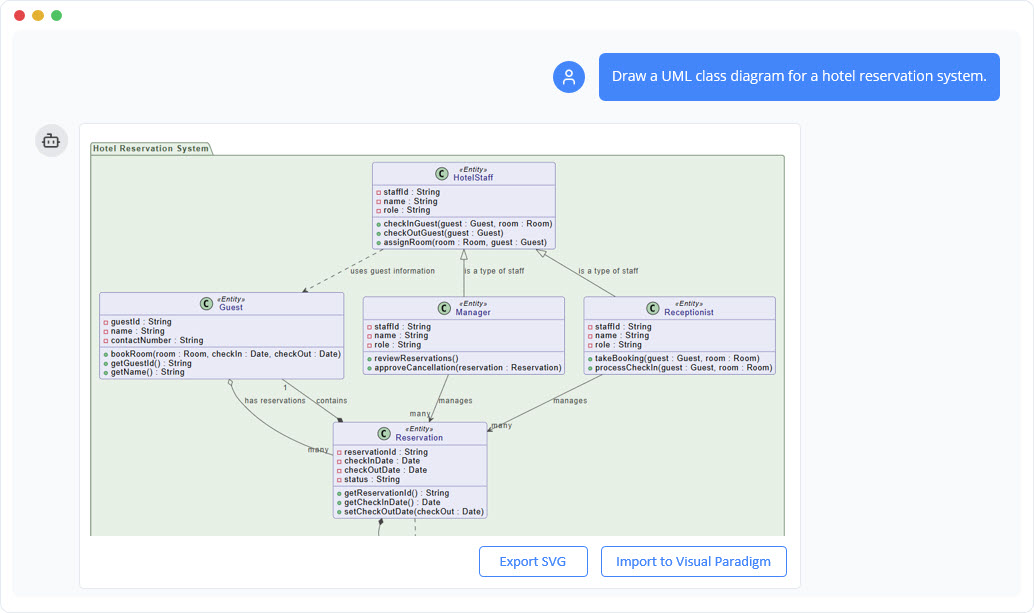AI Architecture Tool: The Blueprint for Modern Domain Modeling
In any large-scale software project, designing a resilient system architecture is non-negotiable. The Class Structure Model is the essential blueprint for this architecture. It provides a static, object-based definition of the system—showing all primary data entities, their behaviors (methods), and how they interact with one another. As the most widely used modeling language in the industry, it is a vital specification tool for technical communication. Historically a time-consuming manual effort, an AI-powered architecture tool now transforms class modeling into a rapid, dynamic, and collaborative design sprint.
This comprehensive guide details the Class Structure Model and demonstrates how an AI assistant will supercharge your architectural design process.

What is a Class Structure Model?
A class structure model defines the static organization of your software. It focuses not on the dynamic flow of data, but on the building blocks of the system and the permanent, reusable relationships between them.
Essential Modeling Components
Entities
- Class: This is the primary container, representing a reusable code template. The AI tool generates this rectangle with three fields:
- Name (the object type, e.g., User, Policy)
- Data Fields (attributes like email: string)
- Actions (methods like calculatePremium())
Links (Relationships)
- Association: A simple logical connection (“is related to”) between two data entities, which is automatically inferred by the AI from your requirement text.
- Aggregation: A flexible “has-a” relationship (represented by a hollow diamond) where one container entity includes others, but the contained entities can still exist independently (e.g., a Project has Tasks).
- Composition: A strong, mandatory “is composed of” link (represented by a filled diamond) where the child entity is entirely dependent on the parent and cannot exist without it (e.g., an Invoice is composed of Line Items).
- Inheritance: An “is-a” structural link (represented by a hollow arrowhead) where a specialized entity inherits data and actions from a general one (e.g., CreditCardPayment is a Payment).
Why Design with an AI Architecture Tool?
Manual class modeling struggles to keep pace with iterative development cycles. An AI-powered tool shifts the focus from drawing to pure design.
Instant Blueprint Generation: Simply feed the AI your data requirements or domain concept in natural language. The tool rapidly converts this into a fully structured, semantically correct class model in seconds.
Automated Pattern Implementation: Design mastery is simplified. Command the AI to apply complex architectural patterns like Facade, Strategy, or Dependency Injection. This ensures your foundation adheres to proven software engineering standards.
Frictionless Design Iteration: Design is iterative, not linear. Refactoring your architecture is now a single prompt. For example: “Restructure the model to extract a common interface from
ReportingServiceandBillingService.” The visual model and underlying definitions update instantly.Direct Code Scaffold Generation: Close the gap between design and development. Once the model is finalized, the AI can generate the boilerplate class code in your chosen language (C#, Python, TypeScript), guaranteeing the code exactly matches the approved structure.
High-Value Uses for the Class Model
The generated class model is a versatile asset used throughout the entire development pipeline.
Domain Modeling with SMEs: Use the tool to co-create the core business domain model with experts, establishing the definitive “ubiquitous language” that serves as the single source of truth for both business and technical teams.
Mapping Database Schemas: The finalized model serves as the blueprint for your relational database. Classes map directly to tables, attributes map to columns, and the AI-defined relationships become foreign key constraints.
API Resource Definition: Use the model to design the resources and data structure for your system’s APIs. The classes and their attributes directly define the JSON objects consumed and produced by your API endpoints.
Modernizing Legacy Code: Reverse-engineer a complex, undocumented codebase by having the tool generate a class structure model from existing code, providing an invaluable visual map for modernization and refactoring efforts.
Generating the Class Model: Example AI Prompts
Precision in your command yields the most accurate model.
Creating Entities: “Model a class called User with private fields
id: GUIDandpasswordHash: string.”Adding Actions: “Give the Order class a public action named
calculateTotal()which returns a double.”Building Links: “Show a one-to-many composition from a
Blogclass to aCommentclass.”Applying Architecture: “Show an inheritance link where
PremiumUserandBasicUserare specialized versions of the User class.”Advanced Commands: “Apply the Factory design pattern. Create a
ShipmentFactoryand an interface forShipmentType.”
A Modern Workflow for Architectural Design
Integrate this AI-powered modeling into your team’s core practices for maximum impact.
Design Spike: Before any code is committed, use the AI to generate a clear class model for the new feature and review it as a team.
Visual Pull Request: Include the AI-generated diagram and code scaffold in your pull request descriptions to give reviewers immediate, actionable architectural context.
Living Documentation: Because the AI makes changes instantaneous, the class model can remain a living, accurate reflection of the system’s current design, ensuring your documentation never falls out of sync with your code.
Conclusion
The Class Structure Model is the bedrock of object-oriented architecture. By replacing the manual friction with an intelligent AI assistant, you liberate your design team to focus on true architectural elegance. This conversational approach to modeling allows teams to design more robustly, iterate faster, and build sophisticated systems that are inherently stable and maintainable.
